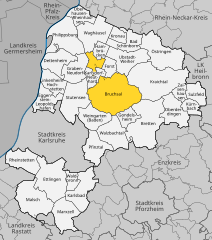Bruchsal | |
|---|---|
 | |
Location of Bruchsal within Karlsruhe district  | |
| Coordinates: 49°08′N 8°36′E / 49.133°N 8.600°E | |
| Country | Germany |
| State | Baden-Württemberg |
| Admin. region | Karlsruhe |
| District | Karlsruhe |
| Subdivisions | 6 |
| Government | |
| • Mayor (2017–25) | Cornelia Petzold-Schick[1] (Greens) |
| Area | |
• Total | 93.02 km2 (35.92 sq mi) |
| Elevation | 114 m (374 ft) |
| Population (2022-12-31)[2] | |
• Total | 46,587 |
| • Density | 500/km2 (1,300/sq mi) |
| Time zone | UTC+01:00 (CET) |
| • Summer (DST) | UTC+02:00 (CEST) |
| Postal codes | 76601–76646 |
| Dialling codes | 07251 and 07257 |
| Vehicle registration | KA |
| Website | www.bruchsal.de |
Bruchsal (German pronunciation: [ˈbʁʊxzaːl] ; South Franconian: Brusl) is a city at the western edge of the Kraichgau, approximately 20 km northeast of Karlsruhe in the state of Baden-Württemberg, Germany. It is located on Bertha Benz Memorial Route.
Bruchsal is the largest city in the district of Karlsruhe and is known for being Europe's largest asparagus producer and one of the economic centers of the region of Karlsruhe. The Bruchsal area also includes the cities and towns of Bad Schönborn, Forst, Hambrücken, Karlsdorf-Neuthard, Kraichtal, Kronau, Oberhausen-Rheinhausen, Östringen, Philippsburg, Ubstadt-Weiher and Waghäusel. Until 1972 Bruchsal was the seat of the district of Bruchsal, which was merged into the district of Karlsruhe as a result of the district reform, effective January 1, 1973.
Bruchsal's population passed the 20,000 mark around 1955. When the new Body of Municipal Law for Baden-Württemberg went into effect on April 1, 1956, the city was therefore immediately awarded Große Kreisstadt status. In addition, Bruchsal cooperates with the neighboring communities of Forst, Hambrücken and Karlsdorf-Neuthard in administrative matters.
- ^ Aktuelle Wahlergebnisse, Staatsanzeiger, accessed 13 September 2021.
- ^ "Bevölkerung nach Nationalität und Geschlecht am 31. Dezember 2022" [Population by nationality and sex as of December 31, 2022] (CSV) (in German). Statistisches Landesamt Baden-Württemberg. June 2023.



